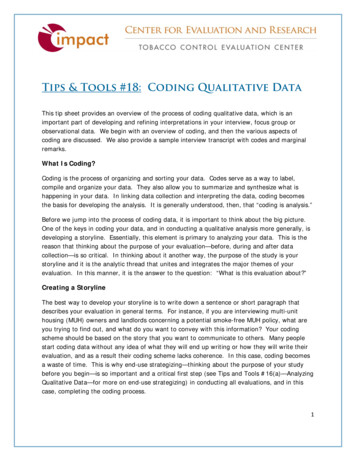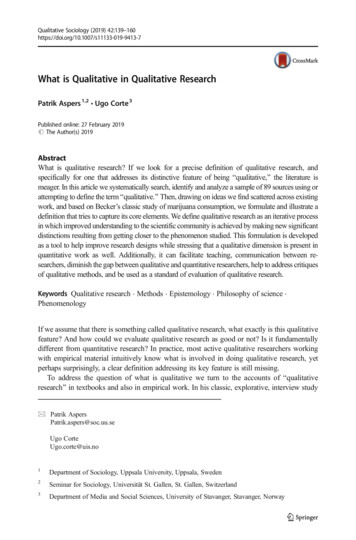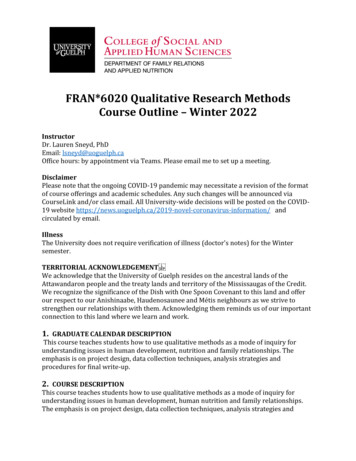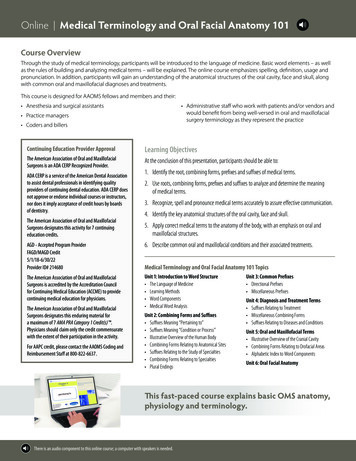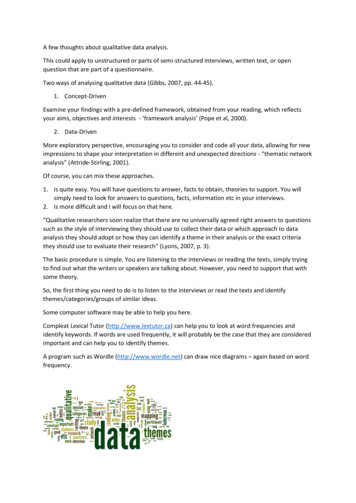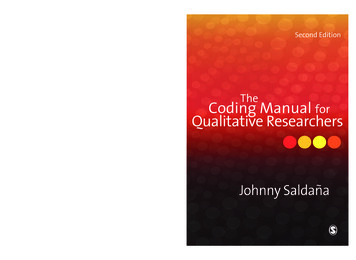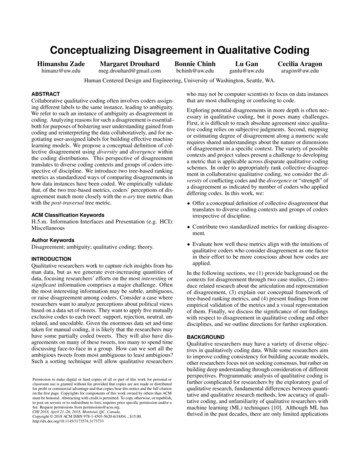
Transcription
Conceptualizing Disagreement in Qualitative CodingHimanshu ZadeMargaret DrouhardBonnie ChinhLu GanCecilia .eduganlu@uw.eduaragon@uw.eduHuman Centered Design and Engineering, University of Washington, Seattle, WA.ABSTRACTCollaborative qualitative coding often involves coders assigning different labels to the same instance, leading to ambiguity.We refer to such an instance of ambiguity as disagreement incoding. Analyzing reasons for such a disagreement is essential–both for purposes of bolstering user understanding gained fromcoding and reinterpreting the data collaboratively, and for negotiating user-assigned labels for building effective machinelearning models. We propose a conceptual definition of collective disagreement using diversity and divergence withinthe coding distributions. This perspective of disagreementtranslates to diverse coding contexts and groups of coders irrespective of discipline. We introduce two tree-based rankingmetrics as standardized ways of comparing disagreements inhow data instances have been coded. We empirically validatethat, of the two tree-based metrics, coders’ perceptions of disagreement match more closely with the n-ary tree metric thanwith the post-traversal tree metric.ACM Classification KeywordsH.5.m. Information Interfaces and Presentation (e.g. HCI):MiscellaneousAuthor KeywordsDisagreement; ambiguity; qualitative coding; theory.INTRODUCTIONQualitative researchers work to capture rich insights from human data, but as we generate ever-increasing quantities ofdata, focusing researchers’ efforts on the most interesting orsignificant information comprises a major challenge. Oftenthe most interesting information may be subtle, ambiguous,or raise disagreement among coders. Consider a case whereresearchers want to analyze perceptions about political viewsbased on a data set of tweets. They want to apply five mutuallyexclusive codes to each tweet: support, rejection, neutral, unrelated, and uncodable. Given the enormous data set and timetaken for manual coding, it is likely that the researchers mayhave some partially coded tweets. They will also have disagreements on many of these tweets, too many to spend timediscussing face-to-face in a group. How can we sort all theambigious tweets from most ambiguous to least ambigious?Such a sorting technique will allow qualitative researchersPermission to make digital or hard copies of all or part of this work for personal orclassroom use is granted without fee provided that copies are not made or distributedfor profit or commercial advantage and that copies bear this notice and the full citationon the first page. Copyrights for components of this work owned by others than ACMmust be honored. Abstracting with credit is permitted. To copy otherwise, or republish,to post on servers or to redistribute to lists, requires prior specific permission and/or afee. Request permissions from permissions@acm.org.CHI 2018, April 21–26, 2018, Montréal, QC, Canada.Copyright 2018 ACM ISBN 978-1-4503-5620-6/18/04 . 15.00.http://dx.doi.org/10.1145/3173574.3173733who may not be computer scientists to focus on data instancesthat are most challenging or confusing to code.Exploring potential disagreements in more depth is often necessary in qualitative coding, but it poses many challenges.First, it is difficult to reach absolute agreement since qualitative coding relies on subjective judgments. Second, mappingor estimating degree of disagreement along a numeric scalerequires shared understandings about the nature or dimensionsof disagreement in a specific context. The variety of possiblecontexts and project values present a challenge to developinga metric that is applicable across disparate qualitative codingschemes. In order to appropriately rank collective disagreement in collaborative qualitative coding, we consider the diversity of conflicting codes and the divergence or “strength” ofa disagreement as indicated by number of coders who applieddiffering codes. In this work, we: Offer a conceptual definition of collective disagreement thattranslates to diverse coding contexts and groups of codersirrespective of discipline. Contribute two standardized metrics for ranking disagreement. Evaluate how well these metrics align with the intuitions ofqualitative coders who consider disagreement as one factorin their effort to be more conscious about how codes areapplied.In the following sections, we (1) provide background on thecontexts for disagreement through two case studies, (2) introduce related research about the articulation and representationof disagreement, (3) explain our conceptual framework oftree-based ranking metrics, and (4) present findings from ourempirical validation of the metrics and a visual representationof them. Finally, we discuss the significance of our findingswith respect to disagreement in qualitative coding and otherdisciplines, and we outline directions for further exploration.BACKGROUNDQualitative researchers may have a variety of diverse objectives in qualitatively coding data. While some researchers aimto improve coding consistency for building accurate models,other researchers focus not on seeking consensus, but rather onbuilding deep understanding through consideration of differentperspectives. Programmatic analysis of qualitative coding isfurther complicated for researchers by the exploratory goal ofqualitative research, fundamental differences between quantitative and qualitative research methods, low accuracy of qualitative coding, and unfamiliarity of qualitative researchers withmachine learning (ML) techniques [10]. Although ML hasthrived in the past decades, there are only limited applications
in qualitative analysis to facilitate the coding process for labeling large datasets using fully or semi-automatic methods [30].Moreover, the inherently subjective nature of qualitative coding results in inconsistencies among different coders, furtherimpacting the quality of coding.It is common for different qualitative coders to disagree aboutthe appropriateness of a code used to label a data instance.When several collaborative qualitative coders differ from eachother in their codes, their disagreement may ambiguate thegroup’s overall understanding of that data instance. Disagreement may also increase complexity for building a ground truthdataset and training strong ML models for qualitative coding. Therefore, it is essential that we address disagreementand focus on identifying points of probable inconsistency inthe context of qualitative analysis. Foundations of disagreement may include unclear code definitions or particular datapoints that collaborators need to negotiate or clarify. Alternatively, disagreement amongst qualitative coders may drawfrom their diverse experiences, priorities, and ways of communicating [4]. While it may be challenging to explore and buildunderstanding around disagreements, the process often yieldsunanticipated insights from the data. Improving methods fordealing with disagreements can therefore improve consistencyand collective understanding in coding while retaining the richperspectives of diverse coders.To illustrate some of the ways in which qualitative codingmight be improved through better processes for recognizingand addressing disagreement, we present insights from twocase studies in the following sections.Case Study IIn order to better understand the role disagreement plays inqualitative coding, we organized an open-ended discussionwith a qualitative researcher in order to understand all aspectsof the coding process and how they could be improved. Whiledescribing one of her ongoing projects, the researcher mentioned the use of disambiguation techniques in her research,which primarily consisted of discussion among coders to derive a consensus and the use of an impartial arbitrator whencoders could not discuss to consensus. The researcher, whooften acted as the arbitrator in her work, also expressed concern whether her own seniority subjected coders to agree withher views or biased coders’ decisions.The use of an arbitrator to resolve conflicts amongst qualitativecoders is a standard norm that utilizes the authority of an individual coder over others involved in the process. We argue thatthe coding process would often benefit from distributed authority for arbitration, rather than privileging one researcher’sperspectives over others. Rather than rely on a single individual’s judgment, we propose that a better authority might be amethod or process that includes thoughtful consideration ofdisagreements and values a multiplicity of perspectives.Case Study IIDisagreements grow more complex as the number of codersincreases. In consideration of this elevated complexity, wepresent another research study in which 3-8 coders coded eachdata instance [22]. In this work, researchers contributed visual analytics tools to provide overviews of codes applied tovery large datasets. For a dataset of 485,045 text instances,coders were able to code around 5% in eight weeks. Visualization is well-suited to human pattern-finding tasks in largedatasets, but may still be challenging to interpret in cases ofvery large datasets or large numbers of coders. The introduction of metrics that automatically sort ambiguous instancesof coded data from most ambiguous to least ambiguous willenable researchers to build better visualizations. By empowering coders with the ability to sort by coder disagreement,such metrics will also be useful in reducing human efforts ofdisambiguation as in this case study.Diversity & Divergence in Conceptualizing DisagreementDisagreement can be characterized through many dimensions.In the scope of our research, we discuss two dimensions—diversity and divergence. Diversity refers to the variationof codes, or labels, used by different coders, where a largerdistribution indicates greater disagreement (e.g., if four codersuse four different labels, there is high diversity). Divergence,on the other hand, refers to clusters of coders agreeing ondifferent labels and thus diverging from each other (e.g. if twocoders choose label 1 and another two coders choose label 2,there is high divergence). Diversity and divergence are notmutually exclusive; high diversity is not devoid of divergence,although low divergence may be seen as a less importantor secondary factor when compared to a situation of highdiversity. In the remainder of this work, we explore shades ofdisagreement through the lenses of diversity and divergencein order to determine which metric(s) for disagreement mightbe most useful for qualitative research.RELATED WORKQualitative coding may be viewed as a set of methodologies toimpose structure on unstructured data through the applicationof “codes,” or analytical labels to related instances of data [28,24]. Given the lack of intrinsic structure in the data, the qualityof coding may significantly impact researchers’ analysis of thecoding scheme [29]. In this section, we provide an overviewof prior work evaluating qualitative coding methods, and offerdiscuss in detail the role that understanding disagreement hasplayed in qualitative coding.Inter-Rater Reliability and DisagreementThe “quality” of coding is subjective and may signify differenttypes and levels of validation in various contexts, but one commonly applied measure to assess coding consistency betweenmultiple coders is inter-rater reliability (IRR), frequently calculated using Cohen’s Kappa [6]. Calculating IRR is a formof quantitative analysis, but has been shown to impact codingquality in a number of cases [16, 20, 3].IRR is the measurement of the extent to which coders assignsimilar scores to the same variable) [25]. The IRR, i.e., degree of agreement amongst different coders may be used toensure that the reported data is an actual representation of thevariables that are measured. To overcome the occasionallyunexpected results yielded by pi (π) and kappa (κ) statistics,which are most widely used for testing the degree of agreement
between raters, researchers have devised alternate agreementstatistics to account for the role randomness plays in agreement between coders [18]. Even given meticulous coding onthe part of all coders, discerning the significance of variousstates and degrees of disagreement may be challenging. IRRmetrics such as Cohen’s Kappa, Cronbach’s Alpha, and othersevaluate inter-rater agreement over a set of data, which maybe most useful for evaluating consistency of coding at a grandscale. In contrast, our metrics rank the degree of disagreementon particular data instances, which allows for consideration ofdisagreement at an instance-level. We provide more discussionabout the significance of forms and degrees of disagreementin later sections.ConsensusOne of the most common techniques for addressing disagreement in qualitative coding is to negotiate toward consensus.In other words, individuals make estimations and negotiatetheir response before reporting the final answer [12]. Priorattempts to realize consensus include use of interaction andvisualization features like distributed design discussions forbringing consensus strategies to unmoderated settings [13].Armstrong et al. have demonstrated through empirical qualitative techniques that while researchers indicate close agreementupon basic themes, they may report different understandingsfrom those similar themes [1]. These findings align with theresults of our expert evaluation where participants indicateddifferent processes (either prioritizing diversity or divergence)to infer the same ranking of disagreement.Diversity and Divergence in Coding and AnnotationWhen it comes to examining variance in qualitative coding,most observational research only assesses agreement, whilereliability is assumed given sufficient agreement. Measuringagreement can: (i) indicate the trustworthiness of observationsin the data, and (ii) provide feedback to calibrate observersagainst each other or against baseline observations. If oneassumes the baseline to be ‘true’, then observer agreementcan be used to assess reliability. As we described above, acommonplace statistic to assess observer agreement, Cohen’sKappa [6], evaluates consistency of coding at a grand scale.For instance-level analysis, we now discuss techniques thatlearn from coder variation and harness the diversity of opinionsfor improving coding results.Systematic divergenceKairam and Heer introduce “crowd parting,” a technique thatclusters sub-groups of crowd workers whose annotations systematically diverge from those of other sub-groups [21]. Theyapplied this technique to crowd-worker annotations, and identified several themes that may lead to systematically different,yet equally valid, coding strategies: conservative vs. liberalannotators, label concept overlap, and entities as modifiers.Sub-groups identified by crowd parting have internally consistent coding behavior though their coding decisions divergefrom the plurality of annotators at least for some subsets ofthe data.Disagreement is signal not noiseDisagreement has long been viewed as an hinderance to thepractice of qualitative coding. However, researchers recentlyhave challenged this view. Through their experimental workon human annotation, Aroyo et al. have debunked multiple“myths” including the ideas that one valid interpretation, ora single ground truth, should exist and that disagreement between coders indicates a problem in coding [2]. Their researchpoints out that disagreement can signal ambiguity; systematicdisagreements between individuals may also indicate multiplereasonable perspectives. Lasecki et al.’s work demonstrates thevalue of both measuring the signal of disagreement, and ranking it among coders [23]. In their tool Glance, they measurecoder disagreement using inter-rater reliability and variancebetween coders labels to facilitate rapid and interactive exploration of labeled data, and to help identify problematic orambiguous analysis queries. Our metrics provide an alternatemethod to sort and filter disagreements, taking into accountthe potential significance of a variety of different states ofdisagreement.Probing disagreement and ambiguitySeveral efforts have attempted to utilize the diversity of opinions for further improving the coding results. The MicroTalksystem successfully exploits crowd diversity by presentingcounterarguments to crowdworkers to improve the overallquality of coding [9]. Another example of such a system is Revolt, a platform that allows crowdworkers to provide requesterswith a conceptual explanation for ambiguity when disagreements between coders occurred. Chang et al. demonstratethat meaningful disagreements are likely to exist regardlessof the clarity or specificity provided in coding guidelines, andthat probing these disagreements can yield useful insightsas to ambiguity within data instances, coding guidelines orboth [5]. While investigating the scope of using disagreementbetween annotators as a signal to collect semantic annotation,researchers have confirmed the need and potential to definemetrics that capture disagreement [11]. This illustrates thevalue of characterizing and probing disagreements among qualitative coders. Our approach is built upon the same premise,but our metrics are based on distributions of codes and placevalue on different dimensions of disagreement: diversity anddivergence.TREE-BASED RANKING METRICS FOR DISAGREEMENTAs more coders assign labels to a data instance, their responsescan either match or conflict with labels assigned by othercoders. We refer to the distribution of labels at any stage ofcoding as a state of agreement. Each new coder labeling thedata instance generates a new state of agreement. For example, if all coders assign the same labels to a data instance, itgenerates a state of complete agreement, i.e., no disagreement.Each additional coder either strengthens the state of completeagreement (by supporting the same label) or weakens it (bychoosing a different label). Therefore, a data instance willenter a new state of agreement with each additional label,regardless of whether the label matched or conflicted withexisting labels.
Given m mutually exclusive labels and n coders, we definea metric for ranking agreement between coders. A tuple oflength m represents the distribution of codes assigned by ncoders across the m labels. For example, a tuple {310} represents the distribution of 4 codes from 4 coders across 3 labels.In this scheme,1. Each element of the tuple represents the number of codersagreeing upon a unique label. For example, a tuple {310}represents 3 coders agreeing on one label, 1 coder assigningsecond label, while no coder assigned the third label.2. The tuple is ordered such that labels upon which morecoders agree are sorted left and labels for which there isless agreement are sorted to the right. This means that thelabel chosen by the highest number of coders will alwaysbe the first element of the tuple, and the label chosen by theleast number of coders will always be the last element ofthe tuple, e.g., {310}.3. Since our approach depends entirely on the distributions ofagreed-upon codes, the order of the tuple is not relevant forranking, but provides clarity in explaining the metric.Next, we present a brief overview of the fundamental principles behind our two tree-based metrics proposed for rankingdisagreement. We describe them in detail in a later section.1. The post-traversal tree ranking (Figure 1): This tree metricfocuses on identifying a coder-group of the maximum possible size which collectively opposes another label chosenby a majority of coders. We utilize dynamic programmingtechniques to structure the nodes such that all states of agreement involving a group of maximum possible size forms theleft sub-tree, while remaining states of agreement are organized under the right sub-tree. A simple postorder traversal(or post-traversal) ranks the disagreement nodes from lessto more agreement.2. The n-ary tree ranking (Figure 2): This tree metric extends upon a previous state of agreement by considering allthe possible labels which a coder can choose. Thus, eachconnected child-node represents different possibilities forcoding that data instance as chosen by the next coder. Whilesome of the states clearly suggest more agreement amongstthe coders, a few states suggest ambiguity between twostates of disagreement. Our ranking algorithm identifiessuch instances of ambiguous degrees of disagreement andranks them based on number of coders who have labeledthe instance.Post-Traversal Tree Metric of DisagreementA top-down view of disagreement can be formulated by considering how a majority agreement about coding a data instancecan be challenged by another group of coders. In other words,given an agreement between n coders about labeling a datainstance, we sequentially explore the possibility of differentn, n 1, n 2.2, 1 coders offering an alternate label for thesame instance. When expressed thus, the problem of computing the different combinations is reducible to the coin changedynamic programming problem 1 . The set of all possible1 https://en.wikipedia.org/wiki/Change-making problemFigure 1. The ranking metric as conceptualized by the post-traversaltree. The 4-length tuples represent the different states of agreement,while the encircled numbers alongside indicate the rank of disagreement based on a simple postorder traversal. The lower the rank, thelower the agreement within that state of agreement. NOTE: The metric only consists of a ranking (low to high agreement) between severalcoding distributions as input by a participant, e.g., order of agreement.{3111} {3110} {3100}., and so on. The tree visualization only offers a conceptual understanding into how the metric is operationalized.group sizes in which coders can collectively agree amongstthemselves correspond to the set of available coins, while thenumber of coders yet to assign labels corresponds to the totalamount of change required.We use the notation (C, n), where C is the number of codersyet to assign labels and n is the maximum number of coderswho can agree on the same label, to refer to the number ofdifferent states of agreement. The notation (C n, n) thencorresponds to the possibilities that n coders agreed to usethe same label for coding a data instance at least once. Theremaining possibilities include all states of agreement whereno n 1 coders agreed on a label, i.e., C coders need to assigna label where no more than n 1 coders agree. Thus, thepossible disagreements represented by (C, n) can be brokendown into (C n, n) and (C, n 1).Figure 1 gives a glance into some of the different states ofcoding agreements that can be reached when 7 coders try toassign any of the available labels to a data instance, given thelimit that a maximum of 3 coders can agree on any singlelabel. The different states of agreement can then be rankedfrom low to high agreement using a post-order traversal as
follows: {3310} {3300} {3220} {3211} {3210} {3200} {3111} {3110} {3100} {3000}.We use a tuple of length equal to the number of total availablelabels to represent a state of agreement, where we assign onedigit for each of the labels to represent the coding. Let tuple{1000} represent a state where one user assigned a label (outof 4 label choices), while other coders have yet to assignany code. Every time the maximum permissible number ofcoders agree to use the same label, we record the new state ofagreement as a coding tuple.Thus, we record a tuple {3300} in Figure 1 to indicate that 2groups of 3 coders have agreed on 2 distinct labels. Each tuplerepresents a state of agreement. Ranking these different tuplesis reduced to a simple post-order traversal of the tree with theleftmost tuple indicating lowest agreement. Algorithm 1 givesthe pseudo-code to recursively compute the rank using thisapproach for any disagreement. Although this approach doesnot uncover any more coding combinations than those in then-ary tree approach introduced in a later section, it supportsabsolute ranking unlike the n-ary tree based ranking that doesnot force-rank ambiguous instances.The dynamic programming based post-traversal tree (Figure 1)is built in a top-down manner. Therefore, this tree prioritizesthe maximum size of group that can oppose any existing majority agreement amongst coders over the choice of a label. Thischain of thought aligns with high divergence and low diversity.We revisit this thought when we discuss our qualitative studywith experts.Algorithm 1 Postorder traversal based ranking algorithm1: C #Coders2: n #RequiredLabels3: o f f set 04: function R ANK(C, n, o f f set). We begin with C n5:L Rank(C n, n, o f f set)6:R Rank(C, n 1, L)7:return L R 1The N-ary Tree Metric for DisagreementConsider the case of five qualitative coders labeling a datainstance using four labels (A, B, C, & D). Let tuple {1000}represent a state of agreement where one user assigned a codeA to an instance, while other coders have yet to assign anycode. There are only two possible outcomes that a secondcoder could generate because they will either agree with theprevious coder or disagree, assigning a new label. Thus, twopossible tuples are available: {1100} or {2000}. The n-arytree presents the possible coding outcomes as more coders areadded. Each tuple is also accompanied by an index i and depthd as (i, d). The index begins at 0 for {1000} and increases ifagreement is added or decreases if disagreement is added. Thedepth also begins at 1 and increases by 1 for every new coder,as new coders create new levels of the tree.With each new coder assigning a label, the n-ary tree (Figure 2)extends a level down and exhausts all the possible states ofagreements that could be reached. By considering all thepossibilities, n-ary tree ensures it does not bias or favor towardsdiversity or divergence, but rather preseves the complexity ofqualitative coding. We revisit this thought when we discussour qualitative study with experts.AlgorithmOur algorithm recursively defines an n-ary tree metric fordisagreement, in which the depth of the tree represents thenumber of coders who labeled a particular data instance. Theroot of the tree represents one coder, with descending levelsadding one coder per level. As such, level d includes all possible distributions of codes that could be chosen by d coders.The ranking metric is achieved through a branching systemthat offers up to three choices from each node t at level i 1in the tree:1. add agreement, representing the ith coder choosing the highest ranked code in node t2. add disagreement, representing the ith coder choosing acode that had not been chosen in node t; and3. add both agreement and disagreement, representing the ithcoder choosing a code that has been chosen but which isnot the highest ranked code in tFigure 2 illustrates the nodes as recursively assigned coordinates based on these three branch choices. Based on these coordinates, Algorithm 2 describes a pseudo-code to decide theorder of agreement. Thus, we demonstrate that it is possible toprovide a simple, standardized technique to rank disagreement.In Section 5, we show that our ranking system aligns withparticipants’ intuitive understandings of disagreement.Algorithm 2 N-ary tree based ranking algorithm1: function R ANK(A, B). A and B are tuples2:a getIndex(A) . Returns tree coordinates of node3:b getIndex(B) . In Fig 2, getIndex(1000) (0, 1)4:if a.col b.col then. If a (1, 2), a.col 15:RankA RankB6:else if a.col b.col then7:RankA RankB8:else9:if abs a.depth b.depth 6 1 then10:RankA RankB11:else if a.depth b.depth then12:RankA RankB13:else14:RankA RankBMTURK USER STUDYStudy DesignWe conducted a user study to validate that the ranking ofagreement as proposed by our post-traversal tree and n-arytree metric aligns with people’s perception of disagreement.Rather than measuring disagreement in the study, we measureperceptions of agreement to avoid negative questions. One ofthe techniques important for assessing inter-rater reliability
Figure 2. The ranking metric as conceptualized by the n-ary tree. Each node represents a state of agreement, and each depth level d represents allthe possibilities of coding an instance with d coders. NOTE: The metric only consists of a ranking (low to high agreement) between several codingdistributions as input by a participant, e.g., (in order of agreement) .{4000} {5000} {6000}., and so on. The tree visualization only offers aconceptual understanding into how the metric is operationalized.involves using the right design for assigning coders to subjects that allows the use of regular statistical methods [19].Likewise, we use a fully crossed design for displaying thedata to our participants in the user study [27]. We offer participants two different representations—(1) a table and (2) avisualization with horizontal stacked bar-charts—to informthe participants how different instances of data are labeled bydifferent coders. The two different types of information representation constitute our independent measure. Participantsself-reported their perceived ranking of agreement (i.e., the dependent measure) of data instances that coders had labeled ina dataset. Our study used a between-subjects counterbalancedmeasures designed to adjust the order effect of learning fromone of the representations.Figure 3. A facsimile of the data representation in the user study indicating 5 data instances coded by 7 coders using 4 different codes. Theempty cells indicate that the corresponding coder chose not to code thatinstance.ParticipantsWe recruited 50 participants through the Amazon Mechanical Turk (MTurk) platform and paid each person 2.25 forcompleting the task. This compensation reflected a minimumwage payment. All partici
in qualitative analysis to facilitate the coding process for label-ing large datasets using fully or semi-automatic methods [30]. Moreover, the inherently subjective nature of qualitative cod-ing results in inconsistencies among different coders, further impacting the quality of coding. It is common for different qualitative coders to disagree .
